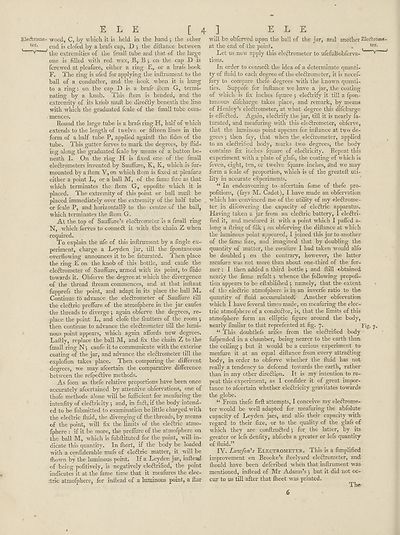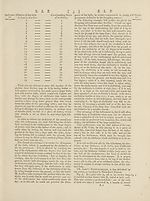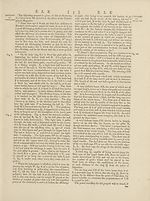Encyclopaedia Britannica, or, a Dictionary of arts, sciences, and miscellaneous literature : enlarged and improved. Illustrated with nearly six hundred engravings > Volume 8, ELE-FOR
(12) Page 4
Download files
Complete book:
Individual page:
Thumbnail gallery: Grid view | List view

E L E [4
Electronic- wood, C, by wliicli it Ls held in the hand; the other
^r" end is doled by a brafs cap, D *, the diftance between
t" v~* ' tjie extrernities of the fmall tube and that of the large
one is filled with red wax, B, B } on the cap D is
fcrewed at pleafure, either a ring E, or a brafs hook
F. The ring is ufed for applying the inftrument to the
ball of a conductor, and the hook when it is hung
to a ring: on the cap D is a brafs fitem G, termi¬
nating by a knob. This Item is bended, and the
extremity of its kriob mull be diredly beneath the line
with which the graduated fcale of the fmall tube com¬
mences.
Round the large tube is a brafs ring FI, half of which
extends to the length of twelve or fifteen lines in the
form of a half tube P, applied againlt the lides of the
tube. This gutter ferves to mark the degrees, by Hid¬
ing along the graduated fcale by means of a button be¬
neath I. On the ring H is fixed one of the fmail
electrometers invented by Sauffure, K, K, which is fur-
mounted by a Item V, on which Item is fixed at pleafure
either a point L, or a ball M, of the feme lize as that
which terminates the Item G, oppofite which it is
placed. The extremity of this point or ball mult be
placed immediately over the extremity of the half tube
or fcale P, and horizontally to the centre of the ball,
which terminates tire Item G.
At the top of Sauffure’s eleffromeier is a fmall ring
N, "which ferves to connect it with the chain Z when
required.
To explain the ufe of this inltrument by a fingle ex¬
periment, charge a Leyden jar, till the fpontaneous
overflowing announces it to be faturated. Then place
the ring E on the knob of this bottle, and caufe the
electrometer of Sauffure, armed with its point, to Hide
towards it. Obferve the degree at which the divergence
of the thread itream commences, and at that inltant
fupprefs the point, and adapt in its place the ball M.
Continue to advance the electrometer of Sauffure till
the eleCtric preffure of the atmofphere in the jar caufes
the threads to diverge; again obierve the degrees, re¬
place the point L, and clofe the Ihutters of the room }
then continue to advance the electrometer till the lumi¬
nous point appears, which again affords new degrees.
Laftly, replace the ball M, and fix the chain Z to the
fmall ring N *, caufe it to communicate with the exterior
coating of the jar, and advance the eleCtrometer till the
explofion takes place. Then comparing the different
degrees, we may afeertain the comparative difference
between the refpeCtive methods.
As foon as thefe relative proportions have been once
accurately afeertained by attentive obfervations, one of
thofe methods alone will be fufficient for meafuring the
intenfity of eledtricity } and, in fa£t, if the body intend¬
ed to be fubmitted to examination be little charged writh
the electric fluid, the diverging of the threads, by means
of the point, will fix the limits of the eledtric atmo¬
fphere : if it be more, the preffure of the atmofphere on
the ball M, which is fubftituted for the point, will in¬
dicate this quantity. In fliort, if the body be loaded
with a confiderable mafs of electric matter, it will be
fhown by the luminous point. If a Leyden jar, inftead
of being pofitively, is negatively electrified, the point
indicates it at the fame time that it meafures the elec-
:iric atmofphere, for inftead of a luminous point, a ftar
] E L E
will be obferved upon the ball of the jar, and another Electrome¬
at the end of the point, . ter-
Let us now apply this electrometer to ufeful-obferva- v
tions.
In order to connect the idea of a determinate quanti¬
ty of fluid to each degree of the eleCtrometer, it is necef-
fary to compare thefe degrees with the known quanti¬
ties. Suppofe for inftanee we have a jar, the coating
of which is fix inches fquare 5 eleCtrify it till a fpon¬
taneous difeharge takes place, and remark, by means
of Henley’s electrometer, at what degree this difeharge
is effected. Again, electrify the jar, till it is nearly fa¬
turated, and meafuring with this electrometer, obferve,
that the luminous point appears for inftance at two de¬
grees ; then fey, that wThen the electrometer, applied
to an eleCtrified body, marks tv/o degrees, the body
contains fix inches fquare of eleCtricity. Repeat this
experiment with a plate of glafs, the coating of which is
feven, eight, ten, or twrelve fquare inches, and we may
form a fcale of proportion, which is of the greateft uti¬
lity in accurate experiments.
“ In endeavouring to afeertain fome of thefe pro-
pofitions, (fays M. Cadet), I have made an obfervation
which has convinced me of the utility of my electrome¬
ter in difeovering the capacity of eleCtric apparatus.
Having taken a jar from an eleCtric battery, I eleCtri-
fied it, and meafured it with a point which I paffed a-
long a firing of lilk j on obferving the diftance at w hich
the luminous point appeared, I joined this jar to another
of the fame fize, and imagined that by doubling the
quantity of matter, the meafure I had taken wmuld alfo
be doubled, 011 the contrary, however, the latter
meafure was not more than about one-third of the for¬
mer : I then added a third bottle ; and ftill obtained
nearly the feme refult; whence the following propofi-
tion appears to be eftabliihed *, namely, that the extent
of the eleCtric atmofphere is in an inverfe ratio to the
quantity of fluid accumulated! Another obfervation
which I have leveral times made, on meafuring the elec¬
tric atmofphere of a conductor, is, that the limits of this
atmofphere form an elliptic figure around the body,
nearly fimilar to that reprefented at fig. 7. Fig. 7.
“ This doubtlefs arifes from the eleCtrified body
fufpended in a chamber, being nearer to the earth than
the ceiling 5 but it would be a curious experiment to
meafure it at an equal diftance from every attraCling
body, in order to obferve whether the fluid has not
really a tendency to defeend towards the earth, rather
than in any other direCapn. It is my intention to re¬
peat this experiment, as I conftder it of great impor¬
tance to afeertain whether eleCtricity gravitates towards
the globe.
“ From thefe firft attempts, I conceive my eleCtrome-
ter would be well adapted for meafuring the abfolute
capacity of Leyden jars, and alfo their capacity with
regard to their fize, or to the quality of the glafs of
which they are conftruCted} for the latter, by its
greater or lefs denfity, abforbs a greater or lefs quantity
of fluid.”
IV. Lawfori's Electrometer. This is a Amplified
improvement on Brooke’s fteelyard eleCtrometer, and
fliould have been deferibed when that inftrument was
mentioned, inftead of Mr Adams’s ; but it did not oc¬
cur to us till after that Iheet was printed.
The
6
Electronic- wood, C, by wliicli it Ls held in the hand; the other
^r" end is doled by a brafs cap, D *, the diftance between
t" v~* ' tjie extrernities of the fmall tube and that of the large
one is filled with red wax, B, B } on the cap D is
fcrewed at pleafure, either a ring E, or a brafs hook
F. The ring is ufed for applying the inftrument to the
ball of a conductor, and the hook when it is hung
to a ring: on the cap D is a brafs fitem G, termi¬
nating by a knob. This Item is bended, and the
extremity of its kriob mull be diredly beneath the line
with which the graduated fcale of the fmall tube com¬
mences.
Round the large tube is a brafs ring FI, half of which
extends to the length of twelve or fifteen lines in the
form of a half tube P, applied againlt the lides of the
tube. This gutter ferves to mark the degrees, by Hid¬
ing along the graduated fcale by means of a button be¬
neath I. On the ring H is fixed one of the fmail
electrometers invented by Sauffure, K, K, which is fur-
mounted by a Item V, on which Item is fixed at pleafure
either a point L, or a ball M, of the feme lize as that
which terminates the Item G, oppofite which it is
placed. The extremity of this point or ball mult be
placed immediately over the extremity of the half tube
or fcale P, and horizontally to the centre of the ball,
which terminates tire Item G.
At the top of Sauffure’s eleffromeier is a fmall ring
N, "which ferves to connect it with the chain Z when
required.
To explain the ufe of this inltrument by a fingle ex¬
periment, charge a Leyden jar, till the fpontaneous
overflowing announces it to be faturated. Then place
the ring E on the knob of this bottle, and caufe the
electrometer of Sauffure, armed with its point, to Hide
towards it. Obferve the degree at which the divergence
of the thread itream commences, and at that inltant
fupprefs the point, and adapt in its place the ball M.
Continue to advance the electrometer of Sauffure till
the eleCtric preffure of the atmofphere in the jar caufes
the threads to diverge; again obierve the degrees, re¬
place the point L, and clofe the Ihutters of the room }
then continue to advance the electrometer till the lumi¬
nous point appears, which again affords new degrees.
Laftly, replace the ball M, and fix the chain Z to the
fmall ring N *, caufe it to communicate with the exterior
coating of the jar, and advance the eleCtrometer till the
explofion takes place. Then comparing the different
degrees, we may afeertain the comparative difference
between the refpeCtive methods.
As foon as thefe relative proportions have been once
accurately afeertained by attentive obfervations, one of
thofe methods alone will be fufficient for meafuring the
intenfity of eledtricity } and, in fa£t, if the body intend¬
ed to be fubmitted to examination be little charged writh
the electric fluid, the diverging of the threads, by means
of the point, will fix the limits of the eledtric atmo¬
fphere : if it be more, the preffure of the atmofphere on
the ball M, which is fubftituted for the point, will in¬
dicate this quantity. In fliort, if the body be loaded
with a confiderable mafs of electric matter, it will be
fhown by the luminous point. If a Leyden jar, inftead
of being pofitively, is negatively electrified, the point
indicates it at the fame time that it meafures the elec-
:iric atmofphere, for inftead of a luminous point, a ftar
] E L E
will be obferved upon the ball of the jar, and another Electrome¬
at the end of the point, . ter-
Let us now apply this electrometer to ufeful-obferva- v
tions.
In order to connect the idea of a determinate quanti¬
ty of fluid to each degree of the eleCtrometer, it is necef-
fary to compare thefe degrees with the known quanti¬
ties. Suppofe for inftanee we have a jar, the coating
of which is fix inches fquare 5 eleCtrify it till a fpon¬
taneous difeharge takes place, and remark, by means
of Henley’s electrometer, at what degree this difeharge
is effected. Again, electrify the jar, till it is nearly fa¬
turated, and meafuring with this electrometer, obferve,
that the luminous point appears for inftance at two de¬
grees ; then fey, that wThen the electrometer, applied
to an eleCtrified body, marks tv/o degrees, the body
contains fix inches fquare of eleCtricity. Repeat this
experiment with a plate of glafs, the coating of which is
feven, eight, ten, or twrelve fquare inches, and we may
form a fcale of proportion, which is of the greateft uti¬
lity in accurate experiments.
“ In endeavouring to afeertain fome of thefe pro-
pofitions, (fays M. Cadet), I have made an obfervation
which has convinced me of the utility of my electrome¬
ter in difeovering the capacity of eleCtric apparatus.
Having taken a jar from an eleCtric battery, I eleCtri-
fied it, and meafured it with a point which I paffed a-
long a firing of lilk j on obferving the diftance at w hich
the luminous point appeared, I joined this jar to another
of the fame fize, and imagined that by doubling the
quantity of matter, the meafure I had taken wmuld alfo
be doubled, 011 the contrary, however, the latter
meafure was not more than about one-third of the for¬
mer : I then added a third bottle ; and ftill obtained
nearly the feme refult; whence the following propofi-
tion appears to be eftabliihed *, namely, that the extent
of the eleCtric atmofphere is in an inverfe ratio to the
quantity of fluid accumulated! Another obfervation
which I have leveral times made, on meafuring the elec¬
tric atmofphere of a conductor, is, that the limits of this
atmofphere form an elliptic figure around the body,
nearly fimilar to that reprefented at fig. 7. Fig. 7.
“ This doubtlefs arifes from the eleCtrified body
fufpended in a chamber, being nearer to the earth than
the ceiling 5 but it would be a curious experiment to
meafure it at an equal diftance from every attraCling
body, in order to obferve whether the fluid has not
really a tendency to defeend towards the earth, rather
than in any other direCapn. It is my intention to re¬
peat this experiment, as I conftder it of great impor¬
tance to afeertain whether eleCtricity gravitates towards
the globe.
“ From thefe firft attempts, I conceive my eleCtrome-
ter would be well adapted for meafuring the abfolute
capacity of Leyden jars, and alfo their capacity with
regard to their fize, or to the quality of the glafs of
which they are conftruCted} for the latter, by its
greater or lefs denfity, abforbs a greater or lefs quantity
of fluid.”
IV. Lawfori's Electrometer. This is a Amplified
improvement on Brooke’s fteelyard eleCtrometer, and
fliould have been deferibed when that inftrument was
mentioned, inftead of Mr Adams’s ; but it did not oc¬
cur to us till after that Iheet was printed.
The
6
Set display mode to:
![]() Universal Viewer |
Universal Viewer | ![]() Mirador |
Large image | Transcription
Mirador |
Large image | Transcription
Images and transcriptions on this page, including medium image downloads, may be used under the Creative Commons Attribution 4.0 International Licence unless otherwise stated. ![]()
| Permanent URL | https://digital.nls.uk/192263575 |
|---|
| Attribution and copyright: |
|
|---|
| Description | Ten editions of 'Encyclopaedia Britannica', issued from 1768-1903, in 231 volumes. Originally issued in 100 weekly parts (3 volumes) between 1768 and 1771 by publishers: Colin Macfarquhar and Andrew Bell (Edinburgh); editor: William Smellie: engraver: Andrew Bell. Expanded editions in the 19th century featured more volumes and contributions from leading experts in their fields. Managed and published in Edinburgh up to the 9th edition (25 volumes, from 1875-1889); the 10th edition (1902-1903) re-issued the 9th edition, with 11 supplementary volumes. |
|---|---|
| Additional NLS resources: |
|

